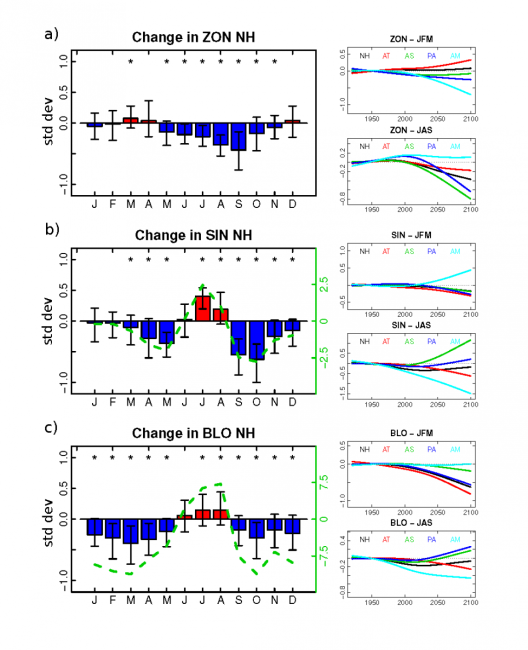Projected changes in mid-latitude atmospheric circulation patterns
Anticipating possible changes in the mid-latitude atmospheric circulation under climate change is crucial for predicting its impacts on surface climate variability. In a new study published in the Journal of Climate, the Community Earth System Model Large Ensemble (CESM-LENS) of simulations is used to explore how various characteristics of the mid-latitude atmospheric circulation (zonal flow, synoptic blockings, jet stream meanders) evolve along the course of the 21st century under the RCP8.5 scenario of anthropogenic emissions. This large ensemble of simulations (that only differ by a small perturbation to their initial atmospheric state) allows the researchers to isolate the forced response to anthropogenic forcing from internal variability.

The findings reveal that changes in the mid-latitude atmospheric circulation are sector-dependent. For instance, a slowdown of the zonal flow and an increase in waviness is found over North America, while the European sector exhibits a reinforced westerly flow and decreased waviness. Concerning the impact on extreme temperature events (winter cold spells, summer heat waves), these dynamical changes appear to be secondary compared to the long-term warming trend that results in fewer and less intense winter cold spells, and more frequent and intense summer heat waves in mid-latitudes.
The circulation changes vary greatly from one ensemble member to the other due to internal variability, highlighting large uncertainties in projected changes in the mid-latitude circulation. However, the researchers identify a robust signal that consists of a narrowing of the wintertime mid-latitude zonal flow, due to competing influences of Arctic Amplification and upper-level tropical warming on both flanks of the mid-latitude jet stream. While the upper-troposphere tropical warming induces a poleward shift of the jet in winter, Arctic Amplification and a weaker stratospheric polar vortex result in the opposite effect. This leads to a faster jet that is confined to a narrower band of latitudes, resulting in decreased or unchanged jet meanders in contrast to what would be expected from the effect of Arctic Amplification alone. This study somewhat reconciles conflicting results about the hypothesized effect of Arctic Amplification and projected changes in mid-latitude flow characteristics.
Late Twenty-First-Century Changes in the Midlatitude Atmospheric Circulation in the CESM Large Ensemble (J. Climate)
1 University of California, Irvine
2 Centre National de Recherches Météorologiques, France
3 University of Wisconsin–Madison
Topics
- Weather
- Modeling
- Climate Change
- Arctic
- Extreme Events
